
Sedum are plants with which compositions are often made, either in pots or planters, or in rockeries. They grow quite fast, and have a high ornamental value, which added to how easy it is to keep them healthy makes them very interesting succulents.
Now, if you want to have a nice collection but you are not sure what species there are, Next we are going to show you the types of Sedum that are most commercialized.
Sedum varieties or types
Sedums are succulents that can be grown both in pots and in the garden. They live well in hot climates, although as you will see, there are many species that are not afraid of frost:
Sedum acre

El Sedum acre, known as pampajarito, is a crass that we find in Europe. Reaches a maximum height of 12 centimeters, and develops stems with green leaves, which sprout from stems that can grow straight or on the ground. The flowers are yellow and star-shaped. Withstands cold and frost up to -20ºC.
Sedum adolphii

Image - Wikimedia / Dryas
El Sedum adolphii it could pass for an Echeveria, another genus of succulent plants that is also easy to grow. It is native to Mexico, and grows as if it were a creeping plant, reaching a height of 30 centimeters. Can't stand the cold.
Sedum album

Image - Flickr / PhotoLanda
El Sedum album, known as cat grape, is a plant of European origin that reaches 30 centimeters in height. Its leaves are glabrous, and it produces white flowers that are grouped in corymb-shaped inflorescences. It withstands very well frosts down to -30ºC.
Sedum amplexicaule

El Sedum amplexicaule It is a small crass, which reaches a height of 10-15 centimeters, native to the Mediterranean region. Its leaves are grayish-green in color, and it produces yellow flowers. It is interesting to have it in the garden, since it supports frosts down to -7ºC.
Sedum brevifolium

Image - Wikimedia / Tigerente
El Sedum brevifolium It is a succulent known as Arrocillo de los Muros, as it is there, as well as on rocky terrain, where it is usually found. It is native to North Africa and Southern Europe, and reaches a height of 14 centimeters. Its leaves are small, green, and it produces white flowers. Supports up to -5ºC.
Sedum clavatum

Image - Flickr / Ryan Somma
El Sedum clavatum it is a crass native to Mexico. Grows forming rosettes up to 10 centimeters high with fleshy green leaves, which are covered with a whitish powder. Its flowers are white. It can resist frosts down to -5ºC.
Sedum dasyphyllum

Image - Wikimedia / Isidre blanc
Known as rice dishes, the Sedum dasyphyllum It is a crass native to Central and Southern Europe that produces very small glaucous leaves and white flowers. It does not usually exceed 10 centimeters in height, but it can be extended up to a foot wide. Resists up to -30ºC.
sedum dendroideum

Image - Wikimedia / Stan Shebs
El sedum dendroideum, known as María's tear, is a plant native to Mexico. Reaches a height of 30 centimeters, and forms rosettes of green leaves with red edges that sprout from a stem. Its flowers are yellow, and it resists cold and frost down to -5ºC.
Sedum forsterianum

Image - Wikimedia / Salicyna
El Sedum forsterianum is a crass native to southern Europe and Great Britain, which reaches a height of 15 to 30 centimeters. Its leaves are green and small in size, and it blooms producing flowers of a striking yellow color. It can withstand frosts down to -12ºC.
Sedum hirsutum

Image - Wikimedia / Alberto Salguero
And what about Sedum hirsutum? It is a miniature plant, native to Africa, perfect to pamper on your terrace. Does not exceed 20 centimeters in height, and has some very cool white flowers. Supports up to -2ºC.
sedum hispanicum

Image - Wikimedia / Salicyna
El sedum hispanicum It is a plant that, contrary to what it may seem, is not native to Spain, but to Central Europe and Western Asia, despite the fact that it is known as Spanish fir. Reaches a height of 20 centimeters. It grows producing fleshy, green, and fleshy leaves. The flowers are white, and are star-shaped. Supports up to -27ºC.
sedum lineare

Image - Wikimedia / Derek Ramsey
El sedum lineare it is a crass native to East Asia. It has a shrubby habit, very compact (does not exceed 15 centimeters in height), and elongated green leaves. In addition, it produces yellow flowers. As if that were not enough, it resists up to -20ºC.
sedum makinoi
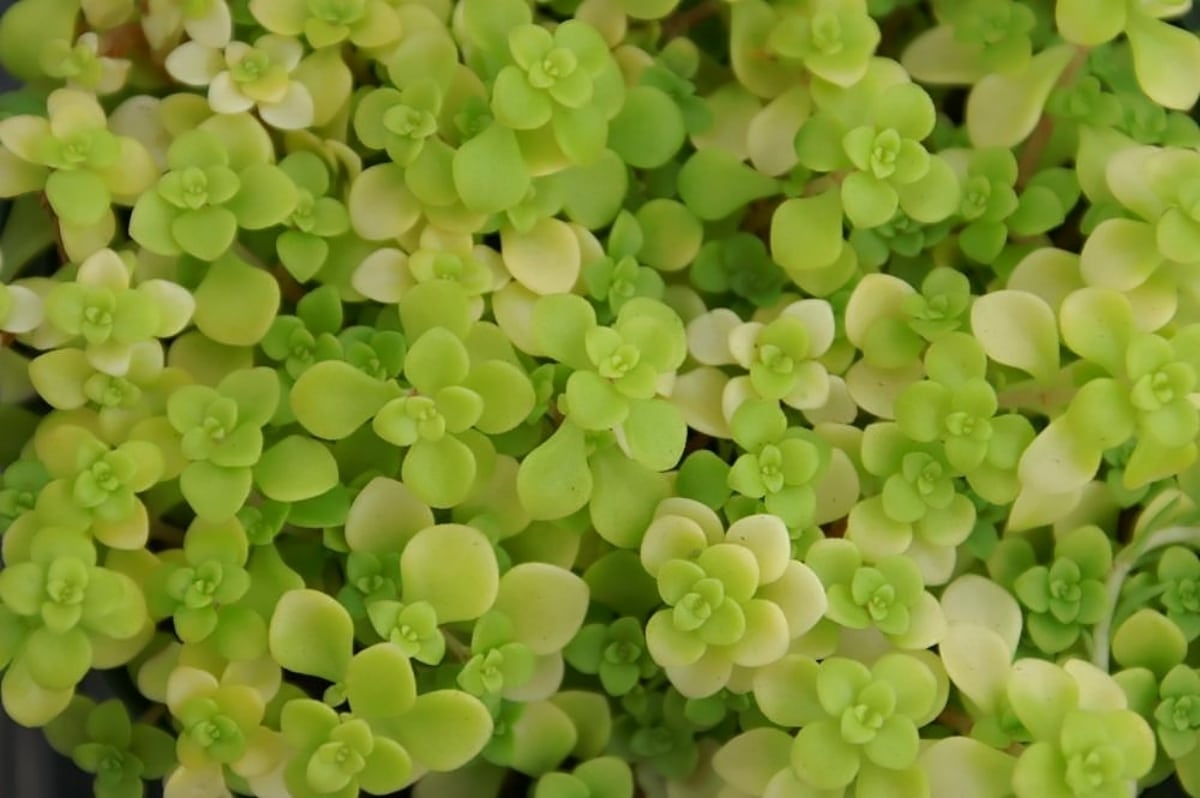
Image - Wikimedia / David J. Stang
El sedum makinoi is a crass native to Asia that reaches a height of 10 centimeters. It has green leaves, round in shape, and small. The flowers are yellow, also small but very showy. It is very resistant, being able to withstand frosts of up to -20ºC.
sedum morganianum
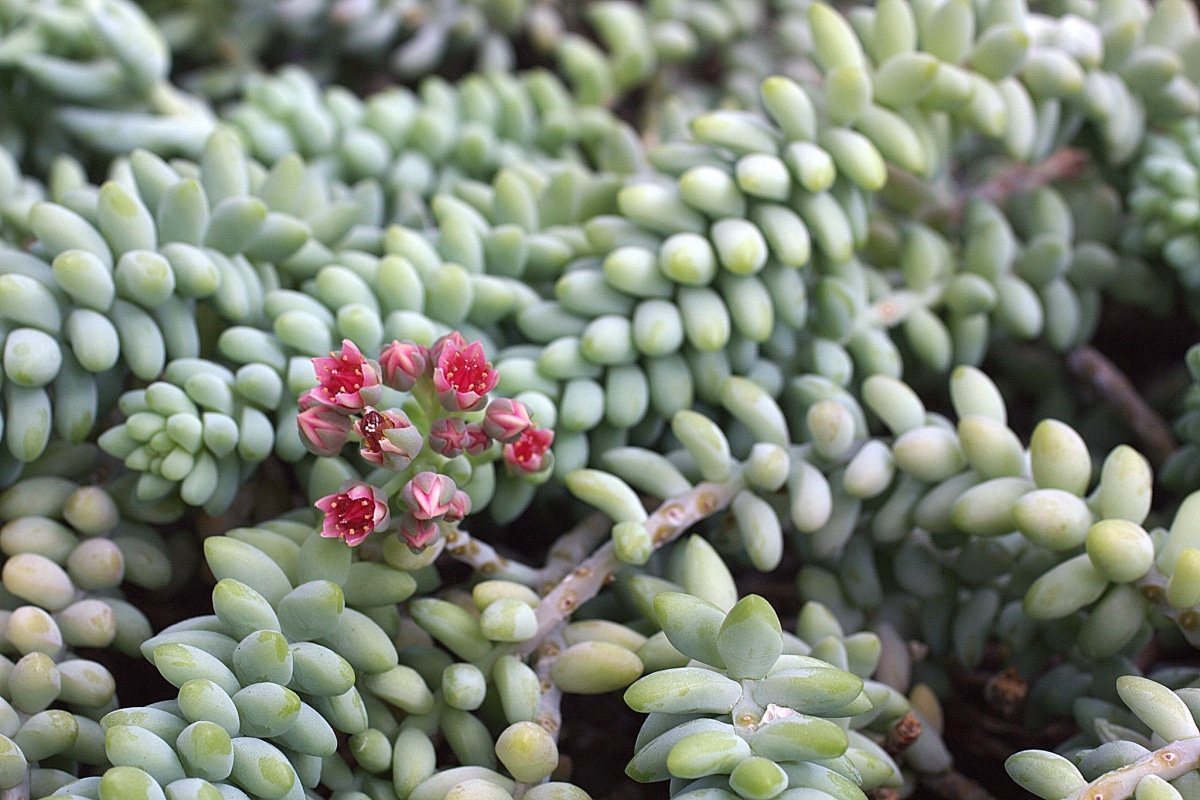
Image - Flickr / manuel mv
El sedum morganianum It is a crass well known by the name of sedum burrito or burro tail. It is native to Mexico and Honduras, and develops hanging or creeping stems up to 30 centimeters long. Its leaves are small, blue-green in color. It produces pink or red flowers at the end of the stems. It does not support the cold, only up to -1ºC if they are specific frosts and of very short duration.
sedum multiceps

Image - ionantha.cz
El Sedum multiceps It is originally from Algeria, and is one of the most widely used as a companion plant for bonsai. It has linear, very short, green leaves that grow grouped in rosettes. Reaches an approximate height of 20 centimeters, and produces yellow flowers. Resists up to -10ºC.
Sedum nussbaumerianum
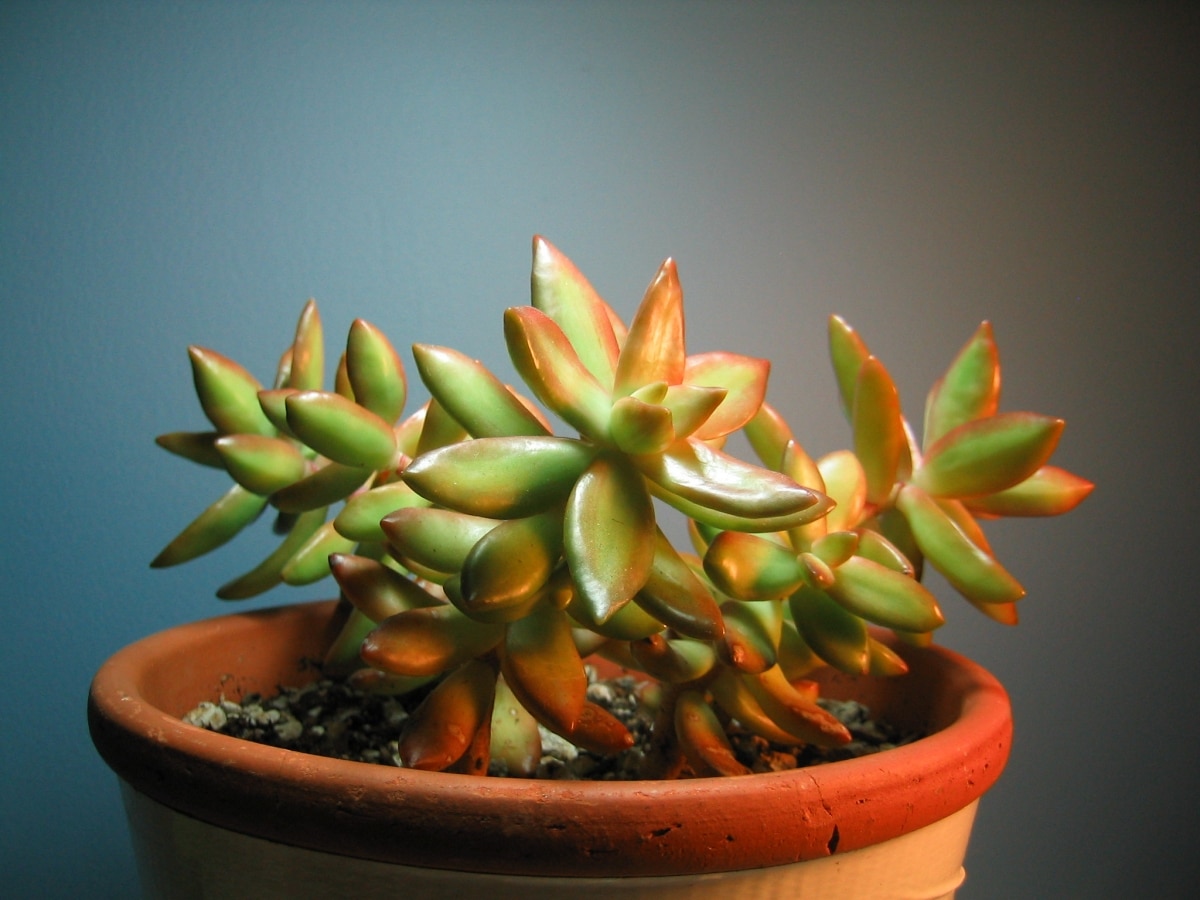
Image - Flickr / Joe Mud
El Sedum nussbaumerianum it is a crass known as golden sedum or coppery silk. It is native to Mexico, and grows to 15 centimeters in height by about 30 centimeters in width. It has elongated leaves, almost triangular in shape, orange-yellow in color. Unfortunately, it cannot stand the cold, only down to -1ºC.
Sedum pachyphyllum

Image - Wikimedia / Illustratedjc
El Sedum pachyphyllum it is a native crass that is believed to be native to Mexico, specifically Oaxaca, but it is not yet clear. Reaches a height of 30 centimeters, with stems that usually grow creeping or hanging from which fleshy and green finger-shaped leaves sprout. The flowers are yellow and star-shaped. Withstands mild frosts, down to -3ºC.
sedum palmeri

Image - Wikimedia / Emmanuel Douzery
El sedum palmeri It is a crass native to Mexico widely used to decorate patios and balconies. Reaches a height of 15 centimeters, and develops creeping stems from which glaucous green leaves sprout with a pink margin. It blooms producing yellow florets. It supports frosts down to -9ºC, although it is better not to have it without protection if it drops below -4ºC.
Sedum praealtum

Image - Flickr / Seán A. O'Hara
El Sedum praealtum It is a crass native to Mexico that has a shrubby habit. It can measure up to 1,5 meters in height, and has yellowish-green spatulate leaves that grow to form rosettes. The flowers are yellow, and sprout from the center of the rosette. Supports up to -3ºC.
Sedum rubrotinctum
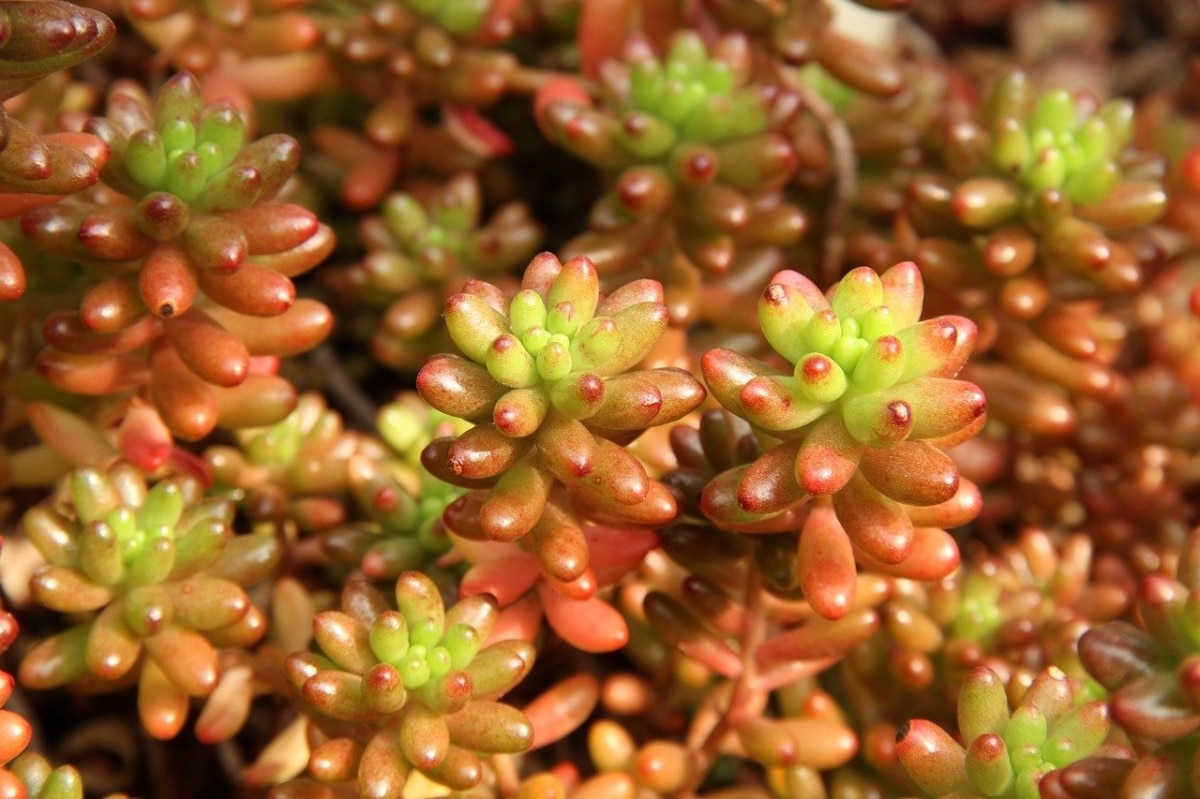
El Sedum rubrotinctum, known as red silk, is a plant native to Mexico that reaches 20 centimeters in height. Its leaves are fleshy, finger-shaped, green, although the tips turn reddish the more the sun hits them. It blooms producing yellow flowers, and resists up to -6ºC.
Rock sedum (before it was sedum reflexum)
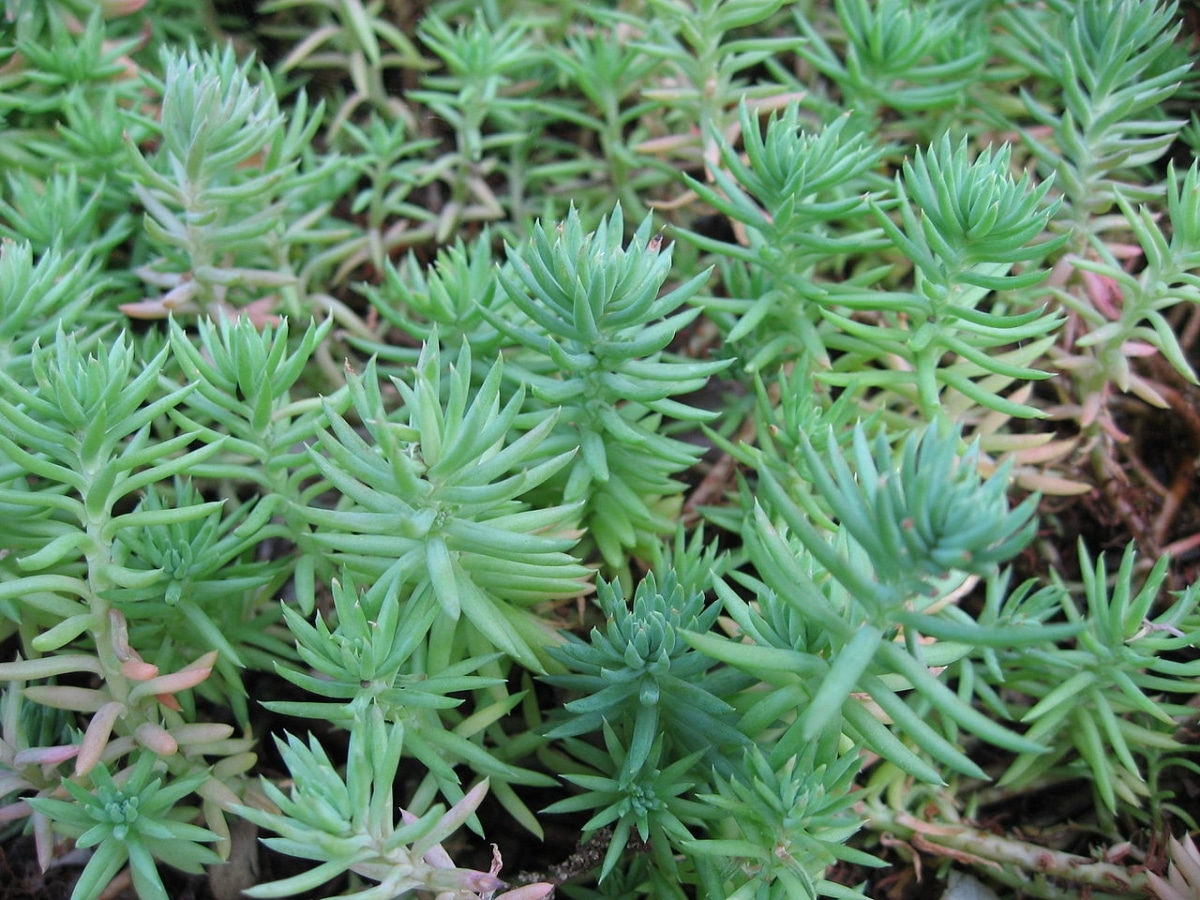
Image - Wikimedia / Liné1
El Rock sedum, known as cat's claw or immortelle, is a Eurosiberian plant that reaches a height of 10 to 40 centimeters, depending on the climate (the warmer, the more it grows). Its leaves are elongated and somewhat fleshy, of a glaucous green color. Its flowers sprout in great numbers from the upper part of the stems, and are yellow. Withstands frosts down to -30ºC.
Sedum sediform

Image - Wikimedia / David J. Stang
El Sedum sediform it is a crass native to the Mediterranean region. It grows upright, reaching a height of 30 to 40 centimeters. It has oblong glaucous blue leaves, and its yellow flowers sprout from a short flower stalk. It resists frosts down to -18ºC.
sedum spectabile (is now Hylotelephium spectabile)

Image - Wikimedia / Jerzy Opioła
The formerly known as sedum spectabile, called autumn sedum, is a crass native to China. Reaches a height of 45 centimeters, and has green leaves with serrated margin. Its flowers are grouped in cymes up to 15 centimeters wide, and they are pink. Once acclimatized, it can withstand -10ºC.
sedum spurium

Image - Wikimedia / Salicyna
El sedum spurium, called silky bastard, is a crass native to the Caucasus that reaches a height of 50 centimeters, although their stems tend to grow horizontally. It has green leaves with a serrated margin, which form rosettes. The flowers can be white, purple, crimson, pink or scarlet depending on the variety or cultivar. Withstands cold down to -20ºC.
Care
Now that you know which are the most common species, let's move on to care. These plants are very easy to care for. In fact, they only need be located in full sun, have a substrate that favors water drainage (such as peat and 50% perlite) or one for cacti and succulents (on sale here), and be protected from frost if they are cold species.
They are not known pests or diseases, but they do the substrate must be allowed to dry between watering and watering Otherwise, the roots could rot due to the presence of fungi. In the rainy season, or if the weather is very humid, you have to watch the snails: these mollusks will not hesitate for a second to take a good bite of Sedum.
For the rest, I can only tell you that you enjoy your plants a lot, which without a doubt they will give you many joys and satisfactions.
Which of these types of Sedum did you like the most?
Hello, I loved knowing more about sedum. I live in Argentina in Patagonia and I have two species of sedum that this winter endured temperatures of -6 ° C and are more beautiful than ever. Kisses
Hello Maria Silvia.
We're glad you liked it.
By the way, if you want, go ahead and upload photos of your Sedum in our Telegram group : )
A greeting.
Hello, in my roof tile some little plants grew among the mosses on the roof tiles. The tiles are very old and the roof tiles have been neglected for several years. I would like to send you a photo so that you can tell me what it is and how to take care of it. I took it out of the ceiling and put it in mini pots. They look like these "crasas", they are several different very cute
Hi Mirna.
You can send the photo to our facebook profile, or telegram group.
A greeting.
Hola!
I have several of these plants, and I love them, but they don't do much for me. The plague falls on them and I don't know if it's because of the soil that I put on it…. It is with compost. Still, not all are given
Hi Jaky.
Sedums need a soil that drains well, such as black peat mixed with equal parts perlite.
A greeting.